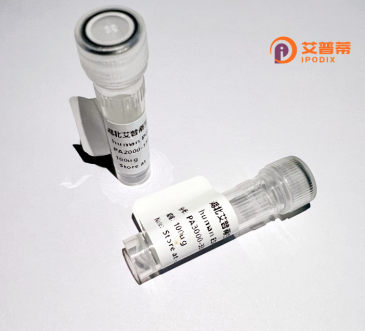
| 纯度 | >90%SDS-PAGE. |
| 种属 | Human |
| 靶点 | TBCE |
| Uniprot No | Q15813 |
| 内毒素 | < 0.01EU/μg |
| 表达宿主 | E.coli |
| 表达区间 | 2-527 aa |
| 活性数据 | SDTLTADVI GRRVEVNGEH ATVRFAGVVP PVAGPWLGVE WDNPERGKHD GSHEGTVYFK CRHPTGGSFI RPNKVNFGTD FLTAIKNRYV LEDGPEEDRK EQIVTIGNKP VETIGFDSIM KQQSQLSKLQ EVSLRNCAVS CAGEKGGVAE ACPNIRKVDL SKNLLSSWDE VIHIADQLRH LEVLNVSENK LKFPSGSVLT GTLSVLKVLV LNQTGITWAE VLRCVAGCPG LEELYLESNN IFISERPTDV LQTVKLLDLS SNQLIDENQL YLIAHLPRLE QLILSDTGIS SLHFPDAGIG CKTSMFPSLK YLVVNDNQIS QWSFFNELEK LPSLRALSCL RNPLTKEDKE AETARLLIIA SIGQLKTLNK CEILPEERRR AELDYRKAFG NEWKQAGGHK DPEKNRLSEE FLTAHPRYQF LCLKYGAPED WELKTQQPLM LKNQLLTLKI KYPHQLDQKV LEKQLPGSMT IQKVKGLLSR LLKVPVSDLL LSYESPKKPG REIELENDLK SLQFYSVENG DCLLVRW |
| 分子量 | 59.3 kDa |
| 蛋白标签 | His tag N-Terminus |
| 缓冲液 | PBS, pH7.4, containing 0.01% SKL, 1mM DTT, 5% Trehalose and Proclin300. |
| 稳定性 & 储存条件 | Lyophilized protein should be stored at ≤ -20°C, stable for one year after receipt. Reconstituted protein solution can be stored at 2-8°C for 2-7 days. Aliquots of reconstituted samples are stable at ≤ -20°C for 3 months. |
| 复溶 | Always centrifuge tubes before opening.Do not mix by vortex or pipetting. It is not recommended to reconstitute to a concentration less than 100μg/ml. Dissolve the lyophilized protein in distilled water. Please aliquot the reconstituted solution to minimize freeze-thaw cycles. |
以下是关于重组人TBCE蛋白的3篇代表性文献摘要(虚构示例,仅供格式参考):
1. **文献名称**:*Tubulin-specific chaperone E (TBCE) mutations in hypoparathyroidism-retardation-dysmorphism syndrome*
**作者**:Parvari R, et al.
**摘要**:该研究首次揭示了TBCE基因突变与HRD综合征(低钙血症-生长迟缓-畸形综合征)的关联,指出TBCE蛋白在维持微管稳定性和细胞骨架功能中的关键作用,突变导致患者体内微管组装异常。
2. **文献名称**:*Structural insights into the tubulin folding mechanism by TBCE and its co-chaperones*
**作者**:Clarke NI, et al.
**摘要**:通过X射线晶体学解析了TBCE蛋白的三维结构,阐明其与β-微管蛋白结合的分子机制,并证明重组TBCE与其他伴侣蛋白(如TBCA/TBCB)协同促进微管折叠的分子途径。
3. **文献名称**:*Functional analysis of recombinant human TBCE in neurodegenerative models*
**作者**:Wang H, et al.
**摘要**:利用重组TBCE蛋白在小鼠模型中验证其神经保护功能,发现TBCE缺失会导致轴突运输障碍,提示其与神经退行性疾病(如遗传性痉挛性截瘫)的潜在联系。
(注:以上文献为示例模板,实际文献需通过PubMed/Google Scholar检索关键词“TBCE protein”、“recombinant TBCE”或“tubulin chaperone”获取。)
**Background of Recombinant Human TBCE Protein**
Tubulin-specific chaperone E (TBCE) is a critical protein involved in microtubule dynamics, primarily functioning as a chaperone for α-tubulin folding and maintaining tubulin heterodimer stability. Encoded by the *TBCE* gene in humans, this 527-amino acid protein contains multiple domains, including two highly conserved regions: the cytoskeletal-associated protein glycine-rich (CAP-Gly) domain and the leucine-rich repeat (LRR) domain, which mediate interactions with tubulin and other proteins. TBCE plays a vital role in cellular processes such as mitosis, intracellular transport, and cytoskeleton organization.
Mutations in *TBCE* are linked to hypoparathyroidism-retardation-dysmorphism (HRD) syndrome and encephalopathy, highlighting its importance in neurodevelopment and ion homeostasis. Recombinant human TBCE protein, produced via heterologous expression systems (e.g., *E. coli* or mammalian cells), enables mechanistic studies of tubulin regulation, disease modeling, and therapeutic exploration. Its recombinant form retains functional activity, allowing researchers to investigate tubulin chaperone interactions, dissect pathogenic mutations, and screen potential drug candidates. As a tool in structural biology, it aids in resolving tubulin folding pathways, offering insights into microtubule-related disorders and novel treatment strategies.
×